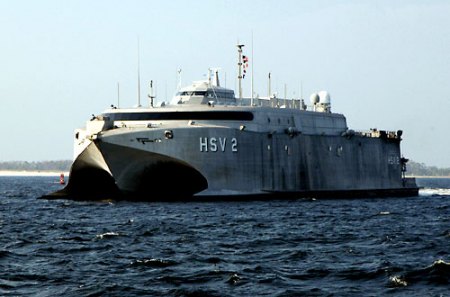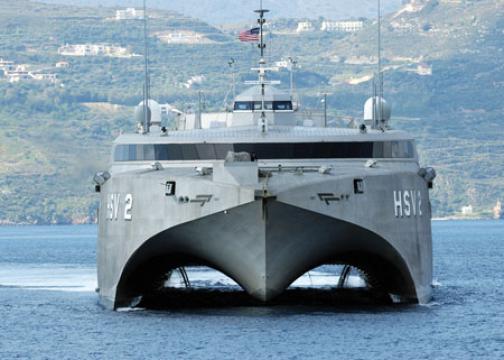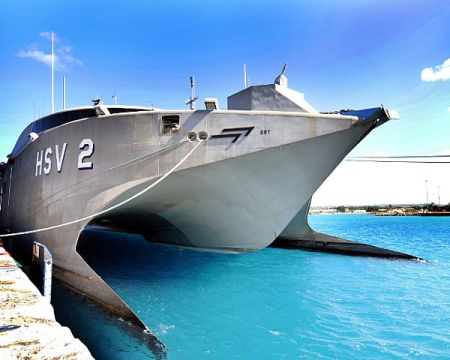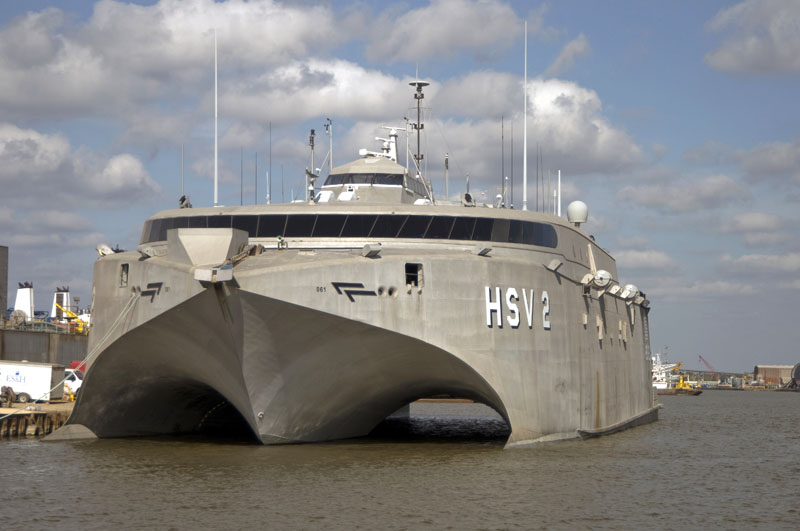
Newest Ship In The Army
35 knots is 40 mph. 45 knots is 52 mph. Pretty damn fast for a cargo boat.
Just over six months after the official opening of Austal’s new Module Manufacturing Facility (MMF) in November 2009, Austal USA hosted a keel-laying ceremony at its shipyard in Mobile, Alabama on July 22, to signify the erection of the first modules on the U.S. Department of Defense’s next generation multi-use platform, the Joint High Speed Vessel (JHSV). This is part of a 10-ship program potentially worth over $1.6b.
Keel Laying is the formal recognition of the start of the ship’s module erection process. In earlier times it was the “laying down” of the central or main timber making up the backbone of a vessel. Today, fabrication of the ship modules begins months before the units are actually joined. However, the keel laying symbolically recognizes the joining of modular components and the ceremonial beginning of a ship.
Spearhead (JHSV 1) will be a US Army vessel (USAV) and its name represents a major feature of the Regimental Insignia of the Transportation Corps. The insignia is a gold color metal and enamel device consisting of a ship’s steering wheel bearing a shield charged with a winged vehicle wheel on a rail, all gold, centered upon a brick red spearhead point up, all standing upon a curving gold scroll spanning the lower tips of the spearhead and inscribed, “Spearhead of Logistics,” in blue letters.
The ceremony signified the erection of the modular components that will form part of a 338 ft aluminum catamaran capable of transporting troops and their equipment, supporting humanitarian relief efforts, operating in shallow waters, and reaching speeds in excess of 35 knots fully loaded. This is the first of a class of 10 vessels to be operated by both the US Army and Navy.
For some old timers who might be wondering if the Army having it’s own ships isn’t some form of wackiness, what I found out about this class of vessels is anything but. For starters, these JSHV ships are fairly inexpensive at under $200 million each, ready to sail. The ships themselves are only slightly modified, armed versions of an existing commercial design, the shallow draft trimaran ferry built by Incat Tasmania Pty Ltd., of Hobart, Australia, now partnered with Bollinger Shipyards of Mobile Alabama and doing business as Austal.
The ships are 338 feet long, and made primarily from aluminum. They are wide beam, shallow draft, light weight, and very stable. They can hit 35 knots or faster, and they use far less fuel than standard ships of their length or capacity. The Navy has been testing a few of them for most of a decade now, and everything seems to work well. The design is pretty odd, and highly modern.



These “little” ships will serve mainly as “floating pickup trucks” moving goods and people. I do not know what their role will be regarding the LCS (littoral combat ship) paradigm. The Spearhead and her sister ships can carry more than 300 troops quickly to shore and back again. This is the same ship design that Hawaii used for an inter-island high speed large superferry, until the enviro-wienies killed it. Those ferries could move 866 passengers and 282 subcompact cars at one go, and used jet propulsion instead of propellers to minimize risk to sea life. But that wasn’t good enough for the greenies!
All in all, it looks like this project was put together with a miraculous amount of common sense. Off the shelf ship that uses a radical but efficient and proven design. Cost effective from one end to the other. See what that kind of ship can do - the earlier ships tested by the Navy were used for logistics support in Iraq, to ferry aid to victims of the Indonesian Tsunami and victims of hurricane Katrina - then grow a role for the military around their capabilities. That’s the exact opposite of the I Have A Hammer approach, where they try to make everything look like a nail.
The JHSV (Joint High Speed Vessel) is a new generation, multi-use platform capable of transporting troops and their equipment, supporting humanitarian relief efforts, the ability to operate in shallow waters, and can reach speed in access of 35 knots fully loaded. The project brings together United States Navy, Army, Marines, and Special Operations Command to pursue a multi-use platform.
Originally built as a car ferry, the Swift [one of the earlier test ships] is a wave-piercing catamaran, a two-hulled, multi-decked craft with the length of a football field. She has a mission bay with 15,500 square feet of vehicle and module space. Her crane can launch and recover small boats. Her vehicle ramp is sturdy enough to accommodate M1A1Abrams tanks. A 4,000-square-foot flight deck has an adjacent hangar for two MH-60S Knighthawk helicopters. She can carry up to up to 250 combat-equipped Marines resting in airliner-style seats and up to 605 tons of cargo.
Propelled by four sets of Caterpillar 3618 marine diesel engines, gas turbines and water jets, she can cruise at a top speed in excess of 45 knots.
Yet the Swift’s aluminum hull draws only 11.15 feet of water. This allows her to operate in the shallow coastal waters of the Gulf of Mexico—or similar regions anywhere in the world. In the two years since the lease began, the vessel has provided transit support during the invasion of Iraq, participated in exercises off the coasts of West Africa, Honduras and Norway and provided tsunami disaster relief in the Indian Ocean.
“The Swift’s high speed makes it extraordinarily responsive, compared to other vessels,” Sodol said. “The higher payload requires fewer trips than a smaller high-speed craft, and the shallow draft enables it to enter ports and use small piers that are inaccessible to deep-draft ships.”
The Army and the Navy are alternating ownership of these ships. The first one built, Fortitude, and this one, Spearhead, are Army ships. #2 and #4, Vigilant and Fall River, will be Navy owned. So maybe it’s wrong for me to call this vessel USS? Maybe USAS instead? Naming conventions are out the window at this point, though the Fall River will be USNS.
Note to dedicated ship spotters: This is not the TSV-1X Spearhead, even though that ship is nearly identical to this one. TSV-1X was a test ship (hence the X) and this one will be a line ship. But the Army so loves the name it will get used on this one as well.
I can’t say how this new class of smaller, chunkier ships will fare in the long run, but one oxymoronic benefit they have is that they are not visually intimidating. Seriously. Maybe we all grew up understanding that the Navy was a floating steel manifestation of Force Projection, but that might be a bit unsettling for other countries when the Navy stops by for a social call.
A now-familiar gray catamaran pulled into the city of Port Antonio, Jamaica, on Jan. 4, carrying a team of sailors and Marines set to deliver a lesson in high demand among all the seafaring nations in Caribbean — how to fix small boats.
Boat repair, port security and basic law enforcement are part of the core curriculum available from the trainers aboard the high-speed vessel Swift, now three nations deep into a seven-nation tour of Central and South America as the United States’ floating embassy. Dubbed the “southern partnership station,” the Swift is becoming a regular visitor to many ports in the 4th Fleet area of operations, which is exactly what the Navy wants.
“This puts the U.S. military in good standing down here with these countries,” said Cmdr. Chris Barnes, the Swift’s mission commander, who spoke to Navy Times from Jamaica.
“In the three countries where we’ve been so far, we’ve been very, very well received. They appreciate the training, and we’re learning stuff from them, as well.”
Hearts and minds ... the theme that just won’t quit. All well and good in peacetime, but the real reason behind these ships is that they can take a quarter thousand soldiers in comfort and all their gear - the equivalent to 20 C-130 cargoes - and get them nearly up on the beach anywhere, and then offload the whole thing in under 15 minutes. Neat rah-rah video here.

Wow! It’s a lot slicker than the converted LST Benowah my Dad served on in Vietnam..
Posted by Reiuxcat 07/24/2010 at 05:39 PM
07/24/2010 at 05:39 PM

the Swift’s aluminum hull draws only 11.15 feet of water.
Aside from being able to operate in shallow coastal waters, seems to me that these might do fairly well in all navigable rivers. When you get right down to it, the Army is better suited than the Navy for river combat/supply/reinforcement.
Of course, only actual combat experience will tell, but I’m impressed.
Posted by Christopher 07/24/2010 at 06:00 PM
07/24/2010 at 06:00 PM

Nah, USS is correct Drew, as it denotes Unites States Ship.
The Army has had more ships than the Navy for a long time, mostly logistics craft and landing vessels.
I think that the Navy will probably find limited use for this hull, since transport duty for them is limited, besides the Marines. I can see it as a decent anti-sub platform with the dual ‘copters, LAMPS anyone? However, with the hull being as light as it is, I don’t see any heavy weaponry..Just a thought..
BillPosted by Doctor DETH 07/24/2010 at 07:59 PM
07/24/2010 at 07:59 PM

Doc, with that nice wide beam I bet it could make a dandy missile platform or UAV carrier. Imagine one so chock-full of launchers it looks like a hedgehog. It might be torpedo resistant with such a shallow draft too.
On the other hand, an aluminum hull won’t even stop rifle bullets will it? I know armor is passe, but I think a military ship ought to at least be bulletproof.
Posted by Drew458 07/24/2010 at 09:17 PM
07/24/2010 at 09:17 PM

Well.. it would be more stable than a single hull, which is the purpose, but it would have trouble stopping a pellet rifle, if the info I have is correct. They would have to reinforce it with Kevlar or some equivalent. Missiles would be good, but they would have to reinforce the decks due to the physics of 9k pounds of thrust against the mounts. The missiles on a frigate have an armor ring that extends 2 decks down that would probably eat into the payload of this ship.
Oh, and an aluminum alloy is used on most newer Navy vessels for the hull, at least since the first Oliver Hazard Perry classes slid down the ways.
They had problems with structural cracks, though this was remedied later. The thin material in the JHSVs would need a LOT of reinforcement, which would slow it down considerably. It would be like using a 8 gauge punt gun on an aluminum dingy.. As my Great Uncle Alphonse would tell you after it ripped the bow off. “Dat was a bad idea, I tell ya what.”
Just a though…
BillPosted by Doctor DETH 07/24/2010 at 09:35 PM
07/24/2010 at 09:35 PM

"On the other hand, an aluminum hull won’t even stop rifle bullets will it?”
Not only is it unarmored but aluminum burns rather easily. Just ask the British sailors that survived the Falklands.
Posted by NavyGunner 07/24/2010 at 11:18 PM
07/24/2010 at 11:18 PM
This is true.. A lesson learned by the HMS Sheffield, Burned until she sank from a single Exocet missile, even though it didn’t explode.. was ignited by the rocket.. Cast aluminum shatters as well. Not good for a fighting ship.
An observation,
Bill